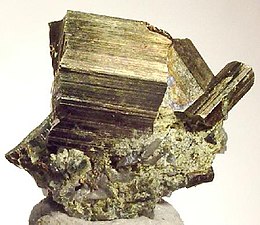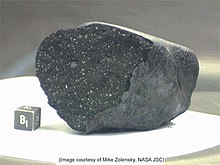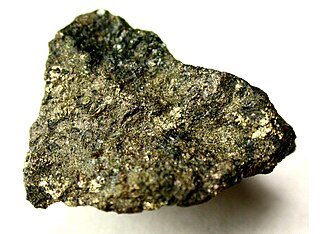
Pentlandite is an iron–nickel sulfide with the chemical formula (Fe,Ni)9S8. Pentlandite has a narrow variation range in nickel to iron ratios (Ni:Fe), but it is usually described as 1:1. In some cases, this ratio is skewed by the presence of pyrrhotite inclusions. It also contains minor cobalt, usually at low levels as a fraction of weight.

Chalcopyrite ( KAL-kə-PY-ryte, -koh-) is a copper iron sulfide mineral and the most abundant copper ore mineral. It has the chemical formula CuFeS2 and crystallizes in the tetragonal system. It has a brassy to golden yellow color and a hardness of 3.5 to 4 on the Mohs scale. Its streak is diagnostic as green-tinged black.

Bornite, also known as peacock ore, is a sulfide mineral with chemical composition Cu5FeS4 that crystallizes in the orthorhombic system (pseudo-cubic).
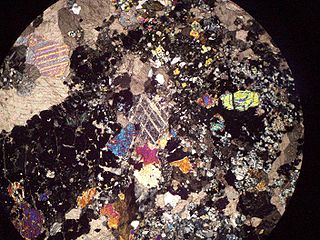
Skarns or tactites are coarse-grained metamorphic rocks that form by replacement of carbonate-bearing rocks during regional or contact metamorphism and metasomatism. Skarns may form by metamorphic recrystallization of impure carbonate protoliths, bimetasomatic reaction of different lithologies, and infiltration metasomatism by magmatic-hydrothermal fluids. Skarns tend to be rich in calcium-magnesium-iron-manganese-aluminium silicate minerals, which are also referred to as calc-silicate minerals. These minerals form as a result of alteration which occurs when hydrothermal fluids interact with a protolith of either igneous or sedimentary origin. In many cases, skarns are associated with the intrusion of a granitic pluton found in and around faults or shear zones that commonly intrude into a carbonate layer composed of either dolomite or limestone. Skarns can form by regional or contact metamorphism and therefore form in relatively high temperature environments. The hydrothermal fluids associated with the metasomatic processes can originate from a variety of sources; magmatic, metamorphic, meteoric, marine, or even a mix of these. The resulting skarn may consist of a variety of different minerals which are highly dependent on both the original composition of the hydrothermal fluid and the original composition of the protolith.
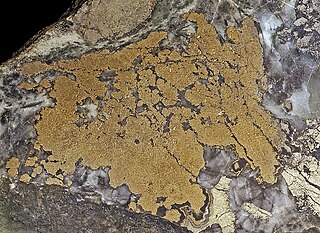
Nickeline or niccolite is a mineral consisting primarily of nickel arsenide (NiAs). The naturally-occurring mineral contains roughly 43.9% nickel and 56.1% arsenic by mass, but composition of the mineral may vary slightly.

Covellite is a rare copper sulfide mineral with the formula CuS. This indigo blue mineral is commonly a secondary mineral in limited abundance and although it is not an important ore of copper itself, it is well known to mineral collectors.

Pyrrhotite is an iron sulfide mineral with the formula Fe(1-x)S. It is a nonstoichiometric variant of FeS, the mineral known as troilite. Pyrrhotite is also called magnetic pyrite, because the color is similar to pyrite and it is weakly magnetic. The magnetism decreases as the iron content decreases, and troilite is non-magnetic. Pyrrhotite is generally tabular and brassy/bronze in color with a metallic luster. The mineral occurs with mafic igneous rocks like norites, and may form from pyrite during metamorphic processes. Pyrrhotite is associated and mined with other sulfide minerals like pentlandite, pyrite, chalcopyrite, and magnetite, and has been found globally.

The mineral marcasite, sometimes called "white iron pyrite", is iron sulfide (FeS2) with orthorhombic crystal structure. It is physically and crystallographically distinct from pyrite, which is iron sulfide with cubic crystal structure. Both structures contain the disulfide S22− ion, having a short bonding distance between the sulfur atoms. The structures differ in how these di-anions are arranged around the Fe2+ cations. Marcasite is lighter and more brittle than pyrite. Specimens of marcasite often crumble and break up due to the unstable crystal structure.
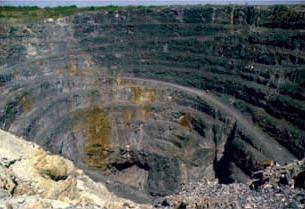
Volcanogenic massive sulfide ore deposits, also known as VMS ore deposits, are a type of metal sulfide ore deposit, mainly copper-zinc which are associated with and created by volcanic-associated hydrothermal events in submarine environments.

Fukuchilite, Cu
3FeS
8, is a copper iron sulfide named after the Japanese mineralogist Nobuyo Fukuchi (1877–1934), that occurs in ore bodies of gypsum-anhydrite at the intersection points of small masses of barite, covellite, gypsum and pyrite, and is mostly found in the Hanawa mine in the Akita prefecture of Honshū, Japan where it was first discovered in 1969. It occurs in masses within the third geologic unit of the Kuroko type deposits within the mine.

Troilite is a rare iron sulfide mineral with the simple formula of FeS. It is the iron-rich endmember of the pyrrhotite group. Pyrrhotite has the formula Fe(1-x)S which is iron deficient. As troilite lacks the iron deficiency which gives pyrrhotite its characteristic magnetism, troilite is non-magnetic.
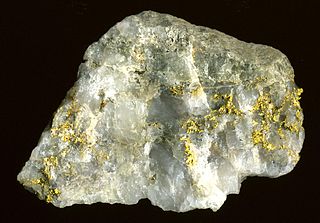
Various theories of ore genesis explain how the various types of mineral deposits form within Earth's crust. Ore-genesis theories vary depending on the mineral or commodity examined.

A layered intrusion is a large sill-like body of igneous rock which exhibits vertical layering or differences in composition and texture. These intrusions can be many kilometres in area covering from around 100 km2 (39 sq mi) to over 50,000 km2 (19,000 sq mi) and several hundred metres to over one kilometre (3,300 ft) in thickness. While most layered intrusions are Archean to Proterozoic in age, they may be any age such as the Cenozoic Skaergaard intrusion of east Greenland or the Rum layered intrusion in Scotland. Although most are ultramafic to mafic in composition, the Ilimaussaq intrusive complex of Greenland is an alkalic intrusion.

Heazlewoodite, Ni3S2, is a rare sulfur-poor nickel sulfide mineral found in serpentinitized dunite. It occurs as disseminations and masses of opaque, metallic light bronze to brassy yellow grains which crystallize in the trigonal crystal system. It has a hardness of 4, a specific gravity of 5.82. Heazlewoodite was first described in 1896 from Heazlewood, Tasmania, Australia.

Mackinawite is an iron nickel sulfide mineral with the chemical formula (Fe,Ni)
1+xS. The mineral crystallizes in the tetragonal crystal system and has been described as a distorted, close packed, cubic array of S atoms with some of the gaps filled with Fe. Mackinawite occurs as opaque bronze to grey-white tabular crystals and anhedral masses. It has a Mohs hardness of 2.5 and a specific gravity of 4.17. It was first described in 1962 for an occurrence in the Mackinaw mine, Snohomish County, Washington for which it was named.
Iron oxide copper gold ore deposits (IOCG) are important and highly valuable concentrations of copper, gold and uranium ores hosted within iron oxide dominant gangue assemblages which share a common genetic origin.
Mooihoekite is a copper iron sulfide mineral with chemical formula of Cu9Fe9S16. The mineral was discovered in 1972 and received its name from its discovery area, the Mooihoek mine in Transvaal, South Africa.

Djerfisherite is an alkali copper–iron sulfide mineral and a member of the djerfisherite group.

Millerite is a nickel sulfide mineral, NiS. It is brassy in colour and has an acicular habit, often forming radiating masses and furry aggregates. It can be distinguished from pentlandite by crystal habit, its duller colour, and general lack of association with pyrite or pyrrhotite.
Farallon Negro is a volcano in the Catamarca province of Argentina. Active between about 9-8 million years ago, it was formerly a stratovolcano or a multi vent volcano. Eventually, erosion removed most of the volcano and exposed the underlying structure including subvolcanic intrusions.
